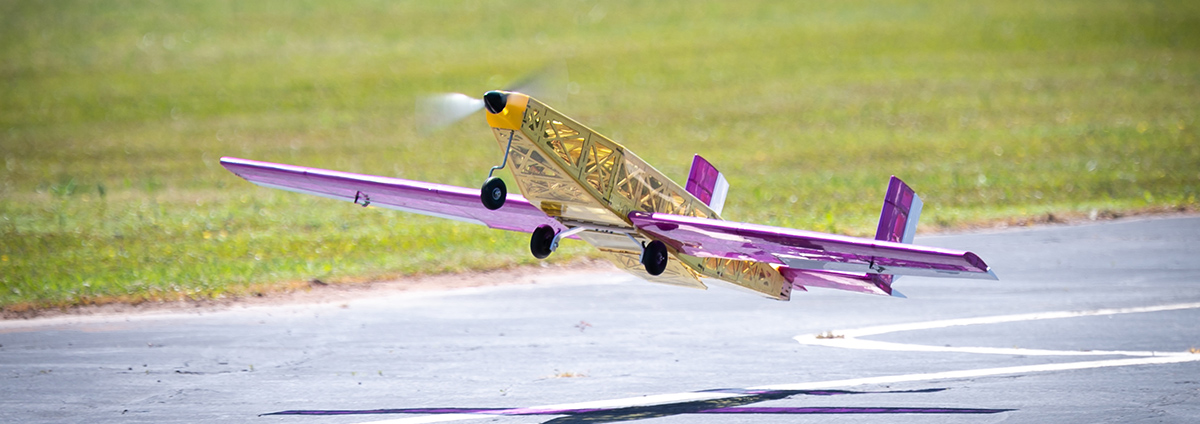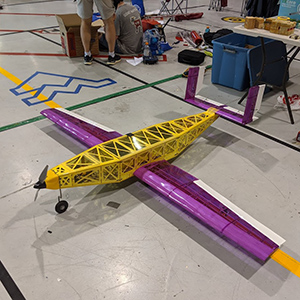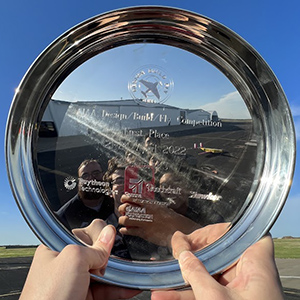
Buzzing to First Place: "P-51 Buzztang" won first place at the AIAA Design Build Fly Competition with the help of sponsors: Aerospace Systems Design Lab (ASDL), Boeing, Rolls-Royce, and the GT Student Government Association.
The Georgia Tech Design, Build, Fly (DBF) team took home first place at the 26th Annual American Institute of Aeronautics and Astronautics (AIAA) Design, Build, Fly Competition, held April 21-24 in Wichita, Kansas. This year’s DBF competition was the first to be held in person since 2019, because the last two years were held virtually due to the COVID-19 pandemic. More than 95 teams from across the world joined the competition which modeled a humanitarian effort to deliver vaccines consisting of three flight missions, one ground mission, and one design report.
 |
| Buzztang waits in the hangar before taking flight |
P-51 Buzztang
The P-51 Buzztang aircraft – a nod to the P-51 Mustang - boasts a seven-foot wingspan, low wing, H-tail configuration, and weights 12.8 pounds. “We decided to go with an H-tail configuration to allow for more stability,” said GT-DBF chief engineer Max Kramer. “We needed to have a wide fuselage to carry the competition payloads, so it made it necessary to go with this configuration”.
Competition
“Only 1.4 points separated first place and second place, so it was great to have in-person competitions back and to see teams working together," said AE School research engineer and GT-DBF faculty advisor Carl Johnson.
During the competition, the Georgia Tech team was able to successfully complete the first two missions in winds that ranged from 25-35 miles per hour. The first flight mission was to fly three laps on the course without a payload to demonstrate airworthiness. The second flight mission was to quickly deliver as many 30 ml syringes over the course of three laps.
 |
| The GT-DBF team has their eyes on the prize...literally. |
“We were able to complete the second mission in less than 1.5 minutes, which equates to an average speed of about 60 miles per hour,” explained Kramer. “That’s really attributed to the incredible job of our pilot Gowtham Venkatachalam, because he is operating the aircraft with no autopilot and no control augmentation in challenging winds”.
The third flight mission was to deliver eight vaccine vial packages without tripping a shock sensor in less than 10 minutes. Teams could only deliver one wooden block each lap and every block had a 25g shock sensor to model a sensitive vaccine payload. Johnson credits the team's successful ground mission to Ty Mancao who did an excellent job loading and unloading the payloads delicately and doing it all in less than 38 seconds. Mancao and team has some assistance when it came to delicately delivering the vaccine payload. “We developed a mechanism that would slowly rotate the vial packages out of the cargo hold, kind of like the conveyer belt that you would see at an airport,” said Kramer.
Though the team didn’t have to battle the wind on the last day of competition, they had a hard landing on their first lap of mission three that broke the nose of the plane. The team was able to scramble and fix the plane and get back in the air to complete the eight laps while also successfully deploying all eight vaccine vial packages.
“I’m most proud of being able to overcome the setbacks from this semester,” said Kramer. “We had a setback during competition, but we also had our own failed attempts during our flight testing that would set us back several weeks at a time. We didn’t get discouraged, we worked through it, learned from our mistakes, and built a better plan. That persistence is what got us to competition and on the podium”.
Next, the GT-DBF team will travel to Fort Worth, Texas to compete in the SAE – East competition May 20-22, where the team will compete in the micro and advanced categories.